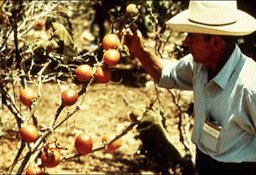From the Manual Of Tropical And Subtropical Fruits
by Wilson Popenoe
The Tree Tomato
Cyphomandra Betacea, Sendt.
Several food-plants which were cultivated by the agricultural
Indians of ancient Peru have become of economic importance to the
modern world, one of them, the potato, of immense value. The
tree-tomato, a bush fruit which was planted in their gardens high upon
the mountain-sides, is now grown in the hill-regions of India and
Ceylon, as well as in several other countries.
In its native
home, where it forms a miniature tree 5 or 6 feet high, O. F. Cook says
the plant is cultivated at elevations of 6000 to 10,000 feet. In
California it grows 8 or 10 feet high. It has large cordate-ovate,
subacuminate leaves, small pinkish flowers, and oblong fruits produced
in clusters of three or more. In length these fruits are about 2
inches; in color and in general character they resemble tomatoes, to
which they are, of course, closely related.
"It has become
thoroughly established in many hill gardens," writes H. F. Macmillan of
the tree-tomato in Ceylon, "and is commonly grown about Nuwara Eliya
for market. The egg-shaped and smooth-skinned fruit, produced in great
abundance and in hanging clusters at the ends of the branches, is in
season almost throughout the year, but chiefly from March to May. At
first greenish purple, it changes in ripening to reddish yellow. The
subacid and succulent fruits are refreshing and agreeable when eaten
raw, but their chief use is for stewing; they may also be made into jam
or preserve. The tree is a quick grower, and commences to bear fruit
when about two years old, remaining productive for several years."
It
has been found in California that the species withstands several
degrees of frost. It may be killed back to the large limbs by a
temperature of 26° to 28° above zero, but it promptly recovers.
In Mexico and Central America, where it is known as tomate, it is
cultivated by the Indians at elevations of 4000 to 8000 feet. It likes
a rich loamy soil and grows best when abundantly irrigated. It does not
require a high degree of atmospheric humidity.
Propagation is effected by means of seeds which germinate readily and develop rapidly into strong plants.

Fig. 62. The tree-tomato (Cyphomandra betacea),
a fruit produced by a half-woody shrub from South America, closely
resembles the tomato in character, and is useful in the same ways as
the latter. (X 1/2)
Back to
Tamarillo Page
|
|